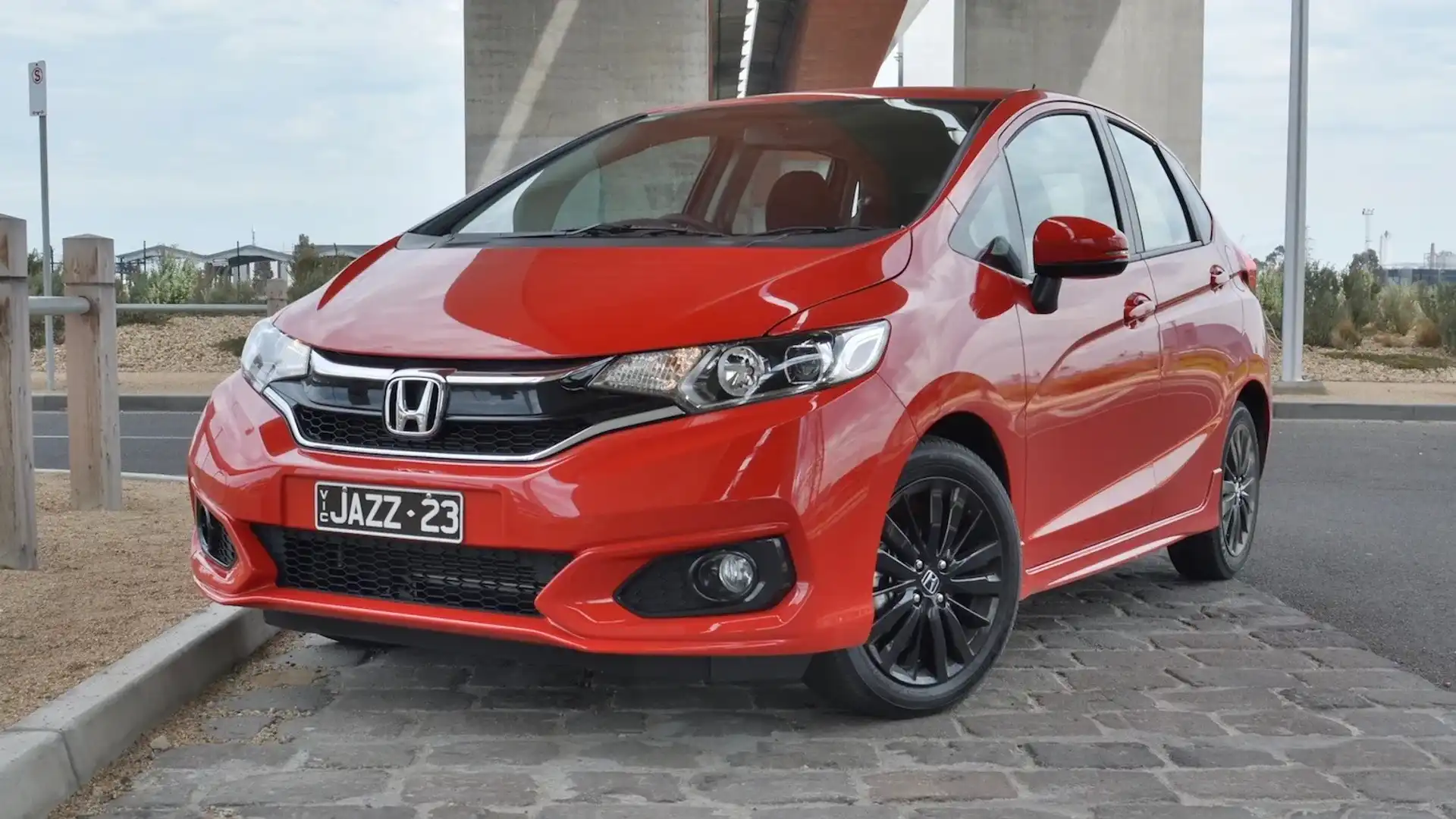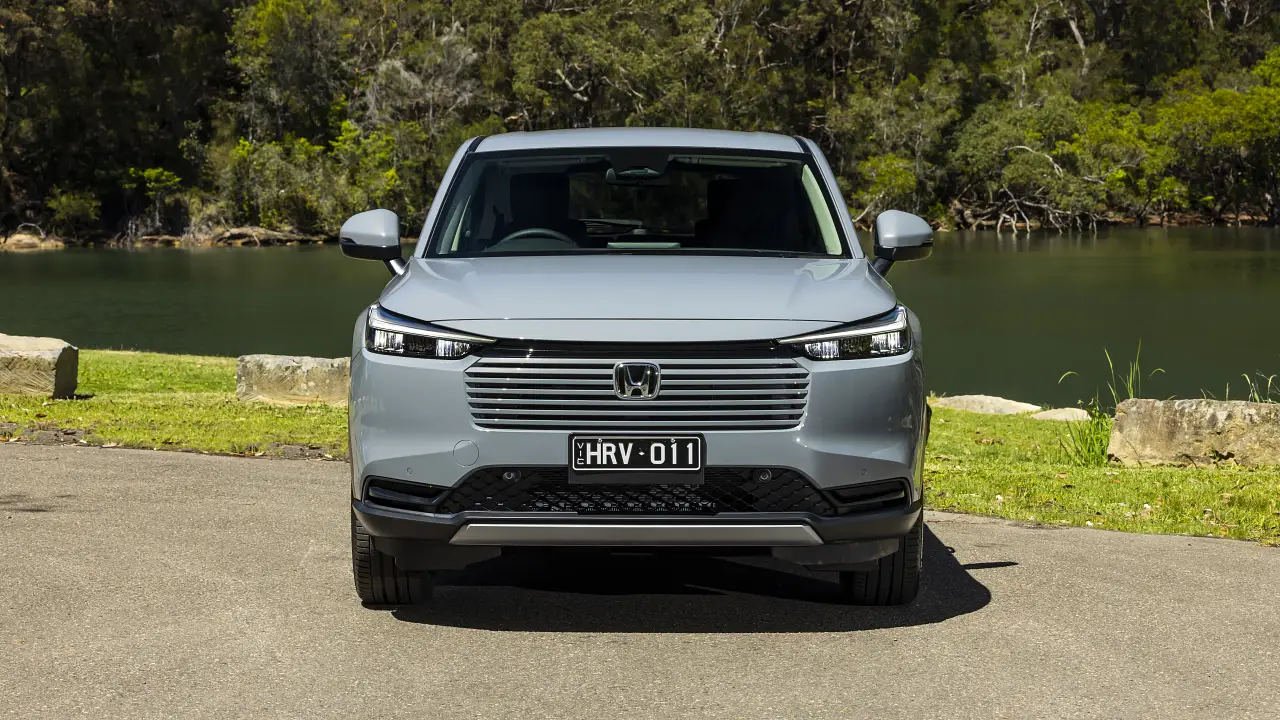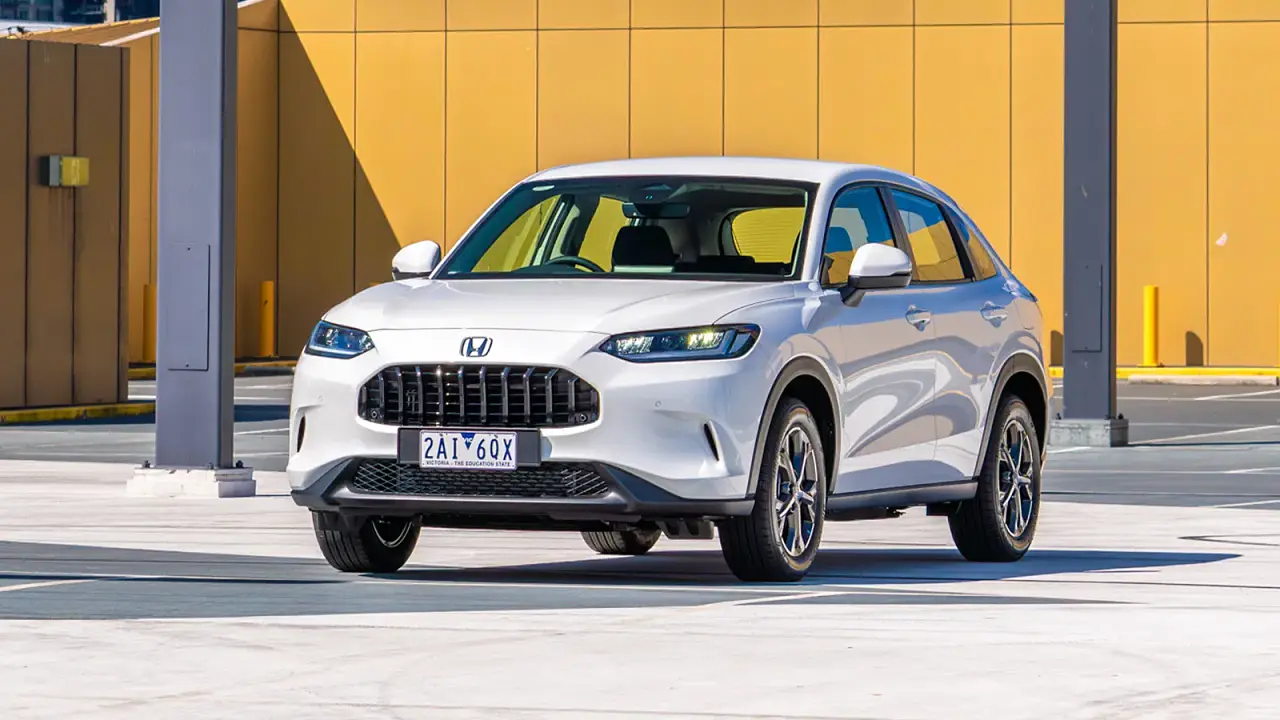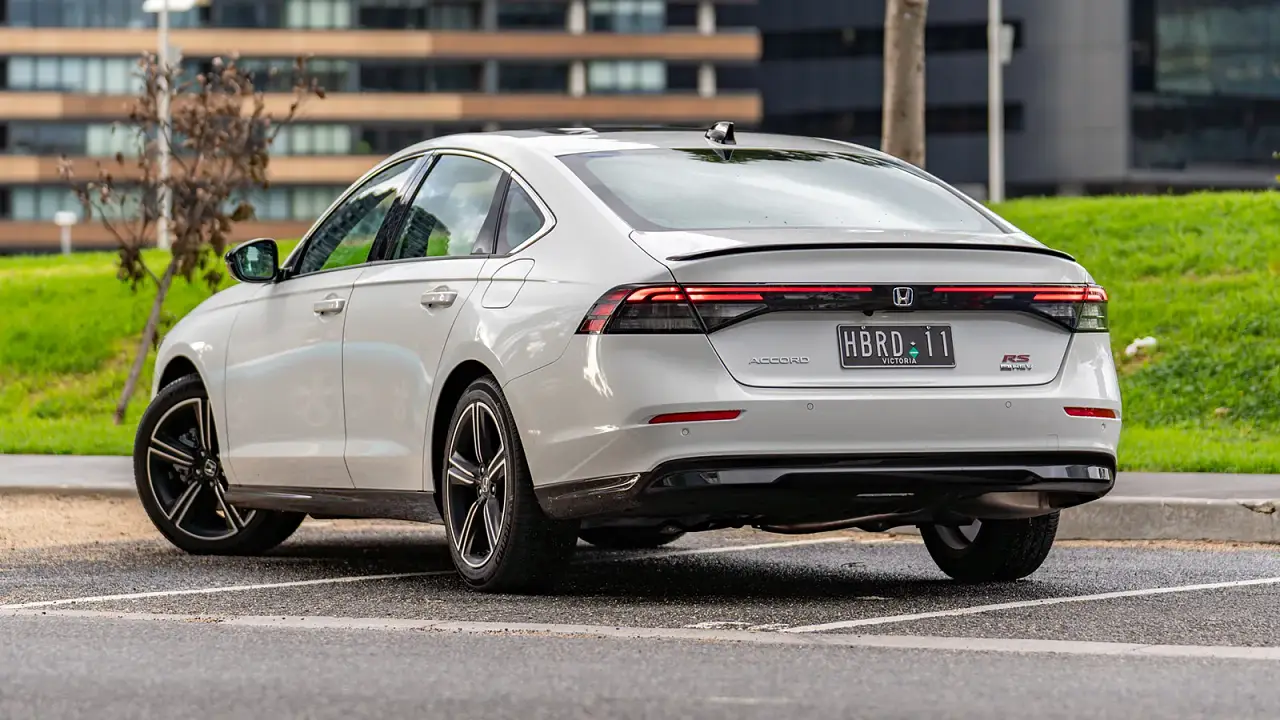- Doors and Seats
NA
- Engine
NA
- Engine Power
88kW, 145Nm
- Fuel
Petrol 5.9L/100KM
- Transmission
NA
- Warranty
NA
- Ancap Safety
5/5 star (2014)
2018 Honda Jazz +Sport review
Consider this 2018 Honda Jazz +Sport limited edition a little red balloon for the light car.
The Jazz is 15 years old this year, meaning that by the standards of a teenager it should be either starting to rampantly rebel or start studiously preparing for senior-school years. There’s no prize for guessing which contrasting character this five-door hatchback conforms to.
Now in its third generation, this Honda remains the intellectual option in its class, as ever focused on space and sensibilities over sex and sports, with one of the most efficient engines up front and one of the largest boots behind. But nothing has changed there in over a decade.
Except this 240-unit limited edition is badged +Sport, based on the middle VTi-S model grade and adding black alloy wheels and exterior trim, plus rear parking sensors for a mere $600 extra. Everything in moderation, if hardly sportiness, then – that’s Jazz, after all…
Vehicle Style: Light car
Price: $20,590 plus on-road costs
Engine/trans: 88kW/145Nm 1.5-litre 4cyl | automatic continuously-variable transmission
Fuel Economy Claimed: 5.9 l/100km Tested: 6.9 l/100km
OVERVIEW
Given the limited equipment additions of this limited edition, it’s probably best to consider this a revisiting of the Jazz model rather than the +Sport model grade. It all starts at $14,990 plus on-road costs for the VTi five-speed manual (the only model grade to get that gearbox) while the automatic continuously-variable transmission (CVT) asks a further $2000 extra.
The VTi-S is priced $3000-higher again, from $19,990 (plus orc), swapping 15-inch steel wheels and hubcaps for 16-inch alloy wheels, while also featuring foglights, LED projector headlights, electric-folding door mirrors and a tailgate spoiler on the outside. Black ‘premium’ cloth is added inside, as are a leather-wrapped steering wheel, centre console storage with second 12-volt outlet, plus integrated satellite navigation arrives on the already-standard 7.0-inch touchscreen with USB/HDMI inputs and Bluetooth connectivity.
This +Sport limited edition, at $20,590 (plus orc), is based on the VTi-S, closing the next $3000 gap to the VTi-L at $22,990 (plus orc). It means the model tested here does miss out on that flagship’s keyless auto-entry with push-button start, bi-LED headlights, leather trim, heated front seats, rear centre armrest, single-zone climate control, and CVT paddleshifters.
Either way, all model grades utilise a 1.5-litre naturally aspirated four-cylinder engine with 88kW of power and 145Nm of torque, which deliver combined-cycle fuel consumption claims of between 5.9 litres per 100 kilometres (CVT) or just 6.5L/100km (manual).
THE INTERIOR | RATING: 3.0/5
Standard Equipment: Remote central locking, electric-folding door mirrors, cruise control, manual air-conditioning, leather-wrapped steering wheel, and power windows and mirrors.
Infotainment: 7.0-inch touchscreen with Bluetooth connectivity, AM/FM radio, USB/HDMI input, satellite navigation and four speakers.
Options Fitted: None.
Cargo Volume: 354 litres.
Back in 2014, when the current generation of Jazz launched, this tester reported that not a single light car competitor has come close to touching the space and versatility of this Honda in the decade-plus since the nameplate debuted. With a 354-litre boot volume, or 1314L with Magic Seats – more in a moment – folded, it was untouchable in a mostly sub-300L class.
Four years on, however, and just this year the new-generation Volkswagen Polo has arrived right on the Honda’s door step by offering 351L/1125L with rear-backrest up and folded respectively. It has only taken 15 years, but a challenger to its supremacy has arrived.
Even so, with the fuel tank positioned under the front seats, a tall rear roofline that doesn’t suffer for style, and a compact torsion beam rear suspension, this +Sport remains the benchmark for space and practicality overall.
Those aforementioned Magic Seats are called that because they ‘float’ above a low rear floor. Feel underneath the three-seat rear bench and there’s simply a black bar that an owner tugs upwards to sandwich bench against backrest, which can deliver a horizontally-split twin boot.
This is the only choice for people who regularly need to squeeze a four-metre-long hatch into tight city parking spots, and who meander through weekend markets to find plants and books.
The Honda Jazz hasn’t changed and it hasn’t aged in these respects. Unfortunately, though, it has in most other ways.
Although the panel fit-and-finish of this Thailand-built, Japanese-badged light car is good, the doors feel clangy, the glovebox lid is undamped and thuds open, the switchgear lacks tactility, plus the touchscreen is the least impressive in the segment. On that latter point, the fiddly and clacky controls aren’t supported by the expected Apple CarPlay/Android Auto smartphone mirroring technology, which is unavailable. Instead the aftermarket-looking sat-nav is slow to respond, its graphics are dated and – even worse – it reflects poorly in the sun.
Tellingly, it’s better to balance a smartphone in the high-mounted driver’s side cupholder, which can act as a phone holder. There are another two cupholders on the lower console anyway, plus a large centre console bin that does round out the excellent level of storage.
It’s just a shame that this hatch is so focused on where stuff goes, rather than those seated inside it. The front seats, for example, are among the least comfortable around, with a tilted-forward seat base and a hard backrest. We know of one owner who dislikes the Jazz’s seat, and a quick Google search indicates there are more out there.
If anything the wide and reclining rear bench is more impressive, and certainly there’s a level of legroom that – yet again – only the new Polo rivals. Except that the newer Volkswagen delivers similar space with greater comfort levels, nicer ergonomics, far superior infotainment and greater active safety technology for about the same price…
ON THE ROAD | RATING: 2.5/5
Engine: 88kW/145Nm 1.5-litre petrol 4cyl.
Transmission: Automatic CVT, FWD.
Suspension: MacPherson strut front and torsion bar rear.
Brakes: Ventilated front disc and rear drum brakes.
Steering: Electrically assisted mechanical steering.
In the near-half-decade since this generation of Jazz launched, rivals have moved quickly to offer equipment such as autonomous emergency braking (AEB). It’s standard on all Mazda2 and Polo model grades, including the $19,690 (plus orc) Maxx auto and $20,490 (plus orc) 70TSI Trendline auto respectively.
Whether it’s +Sport or flagship VTi-L, however, the lack of AEB or any significant active safety equipment beyond electronic stability control (ESC) is now a real disappointment.
Once above $20,000 a greater level of engine and transmission finesse and refinement starts to become expected as well. Volkswagen’s 1.0-litre turbo three-cylinder is deathly silent and unendingly smooth, while the Mazda2’s raucous 1.5-litre four-cylinder is ably supported by a tight and direct six-speed automatic.
Experience with the Honda’s 1.5-litre four-cylinder elevates it significantly as one of the most responsive and most frugal engines in this class, however. That’s further evidenced by on-test economy of 6.9L/100km that was only 1.0L/100km higher than the official claim, even with the CVT regularly in ‘S’ for Sport mode rather than ‘D’ – presumably for drone.
In the regular mode the auto lets the engine fall away to virtually idle, only to respond slowly when the accelerator is quickly pressed. It makes a light car feel slow and sluggish rather than nimble and nippy, as it should and as a manual-equipped Jazz does. The alternative is to engage S, which keeps the engine buzzing at around 3000rpm but makes for quicker response to where the engine outputs are produced (torque at a high 4800rpm, and power at 6600rpm). The downside to this, though, is a lack of refinement.
The engine deserves a better transmission and, for that matter, better steering and suspension.
Even on seemingly modest 16-inch wheels, the Honda jiggles on the freeway, and jolts constantly around town, surfing even tiny bumps as though a skateboard is traversing them. Again, experience with the smaller 15s of the entry-level model reveals an improvement here.
There’s actually decent body control over speed humps, fairly alert and tight handling, as well as reasonably linear response once some lock is wound onto the mid-weighted steering. That said, there’s a vagueness just off the centre position that causes wander on the freeway, and when parking quickly the electric motor for the power assistance turns to treacle.
Especially for a sensible-shoes model with superb practicality, the Jazz package simply deserves greater smoothness and quietness.
SAFETY
ANCAP rating: 5 stars – this model scored 36.58 out of 38 possible points when tested by ANCAP in 2014.
Safety Features: Six airbags, ABS, electronic stability control (ESC), rear parking sensors and reverse-view camera.
WARRANTY AND SERVICING
Warranty: Five years/unlimited km.
Servicing: In addition to below-average bi-annual or 10,000km intervals, Honda charges $259 and $297 for the two required in the first, second, third and fourth year of ownership, which is among the priciest in the class.
RIVALS TO CONSIDER
The Mazda2 Maxx is the smallest in the class – but it’s also among the most fun, best value and safest, should sheer space matter less to you. The Suzuki Swift GL Navigator takes a small step back for fun, but a big step forward for space, particularly in the rear seat – though it lacks quality seating and fit-and-finish.
The Polo 70TSI Trendline may only get hubcaps, but its interior mixes space with quality better than any, while its boot is among the largest and its refinement is unrivalled.
- Mazda2 Maxx
- Suzuki Swift GL Navigator
- Volkswagen Polo 70TSI Trendline
TMR VERDICT | OVERALL RATING: 3.0/5
The best Honda Jazz remains the cheapest VTi featuring a manual transmission. With smaller wheels, without the sluggish CVT, and sans the surcharge of this oddly named +Sport limited edition, it continues a 15-year streak as the pick for space above all else.
Both inside and on the road, this generation of light car has aged, and without a significant mid-life update it best fulfils the simple role of a hatchback unburdened by complexity and offered inexpensively.
As it stands, the +Sport is just too pricey and underdone in terms of seat comfort, ride refinement and powertrain response.
If Honda can make significant gains in the areas mentioned above with a next-generation Jazz, however, then it could be the pick for drivers and passengers – not just their luggage.





































